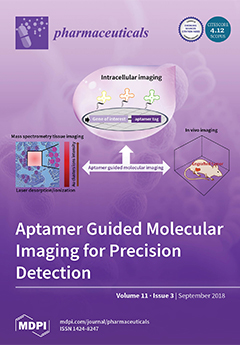This study investigated the potential hepatoprotective effect of oligoribonucleotides-
d-mannitol complexes (ORNs-
d-M) against thioacetamide (TAA)-induced hepatotoxicity in mice. The hepatoprotective activity of ORNs-
d-M was evaluated in thioacetamide (TAA)-treated C57BL/6J. Results indicate that treatment with ORNs-
d-M displayed
[...] Read more.
This study investigated the potential hepatoprotective effect of oligoribonucleotides-
d-mannitol complexes (ORNs-
d-M) against thioacetamide (TAA)-induced hepatotoxicity in mice. The hepatoprotective activity of ORNs-
d-M was evaluated in thioacetamide (TAA)-treated C57BL/6J. Results indicate that treatment with ORNs-
d-M displayed a protective effect at the TAA-induced liver injury. Treatment with ORNs-
d-M, starting at 0 h after the administration of TAA, decreased TAA-elevated serum alanine aminotransferase (ALT) and γ-glutamyl transpeptidase (GGT). Activities of glutathione S-transferase (GST) and glutathione peroxidase (GPx), and levels of glutathione (GSH), were enhanced with ORNs-
d-M administration, while the hepatic oxidative biomarkers (TBA-reactive substances, protein carbonyl derivatives, protein-SH group) and myeloperoxidase (MPO) activity were reduced. Furthermore, genetic analysis has shown that the ORNs-
d-M decreases the expression of mRNA pro-inflammatory cytokines, such as tumor necrosis factor α (TNF-α) and interleukin-6 (IL-6), profibrogenic cytokine-transforming growth factor β1 (TGF-β1), as well as the principal protein of the extracellular matrix—collagen I. The present study demonstrates that ORNs-
d-M exerts a protective effect against TAA-induced liver injury, which may be associated with its anti-inflammatory effects, inhibition of overexpression of mRNA cytokines, and direct effects on the metabolism of the toxin.
Full article






